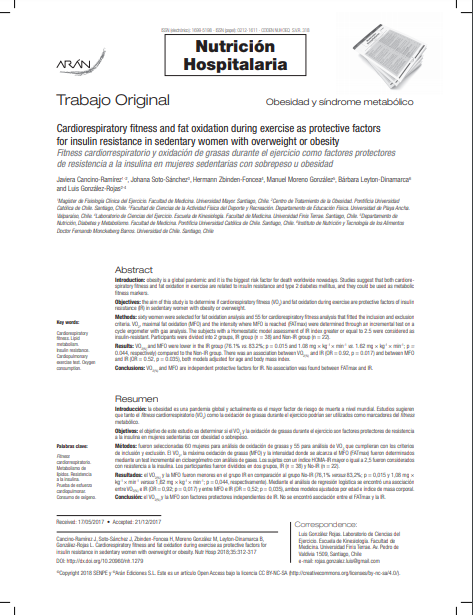Cardiorespiratory fitness and fat oxidation during exercise as protective factors for insulin resistance in sedentary women with overweight or obesity

Fecha
2018Autor
Cancino-Ramírez, Javiera [Univ Mayor, Fac Med, Fisiol Clin Ejercicio, Santiago, Chile]
Soto-Sánchez, Johana
Zbinden-Foncea, Hermann
Moreno González, Manuel
Leyton-Dinamarca, Barbara
González-Rojas, Luis
Ubicación geográfica
Notas
HERRAMIENTAS
Acceda a títulos restringidos
¿Cómo descargar?Resumen
Introduction: obesity is a global pandemic and it is the biggest risk factor for death worldwide nowadays. Studies suggest that both cardiorespiratory fitness and fat oxidation in exercise are related to insulin resistance and type 2 diabetes mellitus, and they could be used as metabolic fitness markers. Objectives: the aim of this study is to determine if cardiorespiratory fitness (VO2) and fat oxidation during exercise are protective factors of insulin resistance (IR) in sedentary women with obesity or overweight. Methods: sixty women were selected for fat oxidation analysis and 55 for cardiorespiratory fitness analysis that fitted the inclusion and exclusion criteria. VO2, maximal fat oxidation (MFO) and the intensity where MFO is reached (FATmax) were determined through an incremental test on a cycle ergometer with gas analysis. The subjects with a Homeostatic model assessment of IR index greater or equal to 2.5 were considered as insulin-resistant. Participants were divided into 2 groups, IR group (n = 38) and Non-IR group (n = 22). Results: VO2(%) and MFO were lower in the IR group (76.1% vs. 83.2%; p = 0.015 and 1.08 mg x kg(-1) x min(-1) vs. 1.62 mg x kg(-1) x min(-1); p = 0.044, respectively) compared to the Non-IR group. There was an association between VO2(%) and IR (OR = 0.92, p = 0.017) and between MFO and IR (OR = 0.52, p = 0.035), both models adjusted for age and body mass index. Conclusions: VO2(%) and MFO are independent protective factors for IR. No association was found between FATmax and IR.
Coleccion/es a la/s que pertenece:
Si usted es autor(a) de este documento y NO desea que su publicación tenga acceso público en este repositorio, por favor complete el formulario aquí.